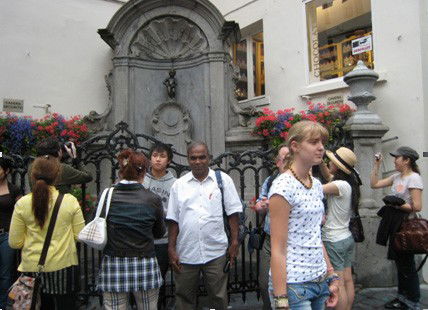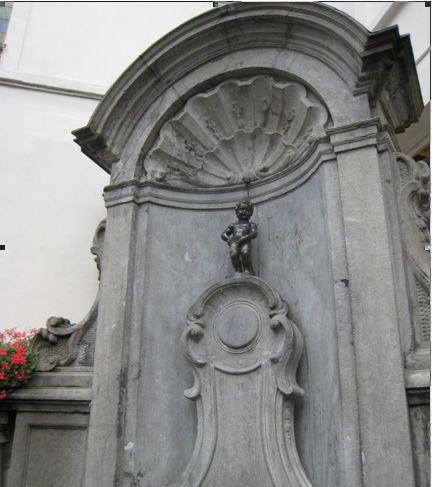America
Manneken Pis in Brussels and the fuss over its portrayal in Air India Ad (Travel with MP Prabhakaran)

(This is Chapter 19 from Mr. Prabhakaran’s book, An Indian Goes Around the World – I: Capitalism Comes to Mao’s Mausoleum, which we have been serializing in this space. Chapter 20, “Norway, Though Expensive, Is Humane and Generous,†will be published next week. Read the series every Monday. – Editor)
Manneken Pis, the famous statue in the Belgian capital of Brussels, had stirred a mini-controversy in India in the late 1960s. The reason? Air India had featured it in one of its advertisements. The advertisements were part of a campaign the airlines launched to promote its recently introduced flights to various European cities, including Brussels.
Some prudes in Bombay (now Mumbai) did not like the idea of their national airlines’ using in its ads the picture of a child holding his penis and urinating. Air India explained to the prudes that the picture of Manneken Pis (meaning “little man piss†in the Dutch language), a statue that is a great tourist draw in Brussels, blended well with the theme of its ad campaign. The prudes wouldn’t buy it. Nor were they pacified by the humorous twist Air India had given to Manneken Pis: The ad showed not just the little man pissing, but a passerby warding off the ‘urine’ with an umbrella as well.
I was a journalism student in Bombay when the controversy erupted. I remember getting into heated arguments with some of those prudes who took Air India to task for the advertisement’s alleged offense to Indian mores. They wouldn’t even utter the word penis, let alone portray it in a national airlines’ advertisement.
I remember asking them: “What about the pictures that are hung on the walls of your homes and sculptures that exist in temples around India, showing gods and goddesses engaging in all kinds of natural acts, including sexual intercourse? And what about that adorable picture of Lord Krishna, as a child, eating stolen butter with one hand and fondling his penis with the other?†I even told them that, if I had money, I would drag them all to Brussels and force them to stand underneath the Manneken Pis statue and “take a picture of the piss falling on your heads.†I knew even then that what came out of the statue was drinkable water.
Air India’s advertisement and the controversy it generated came back to mind during my visit to Brussels in the summer of 2008. After taking a good look at Manneken Pis and spending some time with the crowd around it, I requested a young lady from an Australian tour group to take a picture of me posing in front of it. “Make it look as though the piss is falling on my head,†I told her.
I knew that there was no danger of even that drinkable water falling on my head. The place where the statue stood and the water fell was fenced off. When some people in the crowd burst out laughing at my remark, I told them the story behind it. “There are such characters in every country,†one of them said.
Stories surrounding Manneken Pis are many. One of them is linked to Duke Godfrey III of Leuven (or Lower Larraine). He was only two years old when he assumed dukedom, in 1142. The same year, a battle broke out between his troops and the troops of the Berthouts, the lords of Grimbergen. The battle took place in Ransbeke, the present-day Neder-over-Heembeek. Hoping to get inspiration from the infant ruler, the troops of Leuven put him in a basket and hung it from a tree at the scene of the battle. The infant, they say, urinated on enemy troops and the latter lost the battle.
Another story goes thus: In the 14th century, Brussels was besieged by French troops. They were about to destroy the city with explosives, which they had already placed at the walls of the city. When a little boy by the name of Juliaanske, who had been spying on the enemy, saw the fuse of the explosives burning, he urinated on it. It is said that the statue of Manneken Pis was built in honor of the little boy’s urination that extinguished the enemy’s burning fuse and saved the city from destruction.
A third legend has it that the statue was built by a wealthy merchant as a token of gratitude to the people of Brussels. He was on a visit to the city with his family. He had been wandering around, oblivious of the surroundings, when he suddenly found that his little son was missing. He and the other members of the panic-stricken family searched for the boy all over the city. Many city residents also joined in the search. The search ended, to the great relief of the family and amusement of others in the search party, when one of the latter spotted the little boy “happily urinating in a small garden.†The Manneken Pis, according to this story, is a monument built by the merchant as a gift of gratitude to the Belgians who helped him find his darling son.
Original Statue Was Stolen
The original stone statue, erected as early as 1388, was stolen and replaced several times. The two-foot-tall bronze statue, which we see today at the corner of the streets, rue de l’Etuve and rue Chênet, was created in 1619 by sculptor Jerome Duquesnoy.
Every time I passed by the statue – I did it three times – during my four-day stay in Brussels, there was a crowd of tourists jostling with one another to take a good look at it. “If only those prudes in Bombay who argued with me years ago had witnessed this scene,†I said to myself, looking at the crowd that was admiringly and amusedly watching the manneken pissing, with the penis held between his fingers.
I was not lucky enough to see the ‘little boy’ in one of his 600 costumes. The costumes, “most of which are freaking hilarious,†according to Willy Volk, are on display at the Musée de la Ville de Bruxelles.
No matter what the prudes and puritans say, Manneken Pis will survive and continue to attract crowds from around the world. There is no doubt about it. I wish I could say the same about the country in which the statue stands. The intense hostility that has been going on for a long time between Flanders in the northern part of the country and Wallonia in the south has raised real concerns about the survival of Belgium as one nation. It is my hope and prayer that Belgians find a way of ending the hostility and keeping their beautiful country intact.
Photo:
Manneken Pis, a statue showing a little child urinating, in Brussels, the capital of Belgium. The statue, which is a big tourist draw, had stirred some controversy in Mumbai, in the late 1960s, when Air India used it in an advertising campaign to promote its newly introduced flights to Brussels.
Photo: 2The
author, with fellow tourists, at the Manneken Pis statue, in Brussels.
(To be continued)
(M.P. Prabhakaran can be reached by email at [email protected]
18
Chat with an Austrian-Muslim woman determined to remain modern (Travel with MP Prabhakaran)
Chapter 17
A Bridge on Austrian border; a memory lane to the Hungarian Revolution (Travel with MP Prabhakaran)
chapter 16:
Monuments in Mexico City that pose challenge to the US (Travel with MP Prabhakaran)
15
What makes Islamic Turkey different from Islamist Saudi Arabia
14) Garbage dumps and traffic jams in the Silicon Valley of India
see also: 13
A humbling experience in a Laotian Town
(To be continued)
(M.P. Prabhakaran can be reached by email at [email protected])
12
A morning walk by the Mekong; A restaurant named after my niece
Chapter: 11:
A jacket and a bride for the price of one: Shopping on Nanjing Road (Travel with MP Prabhakaran)
10:
How a Shanghai neighborhood got an Indian name
9:
Capitalist celebrations in Communist China – on May Day (Travel with MP Prabhakaran
8) Capitalism Comes to Mao’s Mausoleum – But in Its Crude Form
7) Picture of a cow on Beijing billboard confuses a Hindu (Travel with MP Prabhakaran)
6) Yoga on Copacabana, conducted by a Brazilian beauty (Travel with MP Prabhakaran)
5
Hunchback and sugar loaf: Two tourist attractions in Rio de Janeiro
4)
How Portugal failed to colonize Calicut: Chat with a Brazilian
3) Brahma and Laxmi reincarnate in Brazil? (Travel with M.P. Prabhakaran)
2) Eva Peron’s tomb is too small for her ego (Travel with M.P. Prabhakaran)
1) My Two Embarrassing Moments in Buenos Aires (Capitalism Comes to Mao’s Mausoleum-1: M. P. Prabhakaran)
http://dlatimes.com/article.php?id=40709
(about the author) An Indian Goes Around the World – I (Capitalism Comes to Mao’s Mausoleum)http://dlatimes.com/article.php?id=40126

 Manneken Pis, a statue showing a little child urinating, in Brussels
Manneken Pis, a statue showing a little child urinating, in Brussels 












































